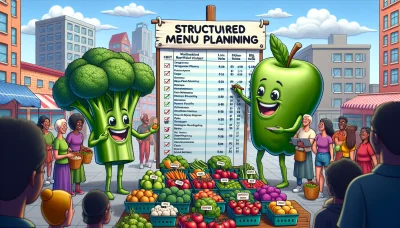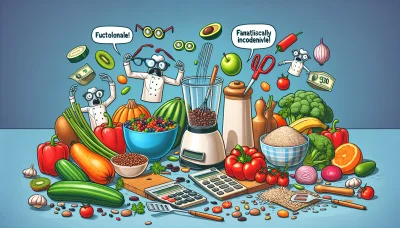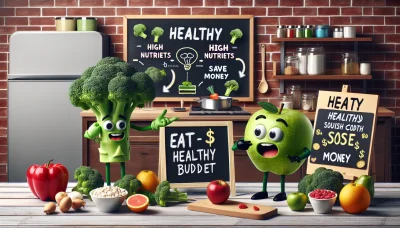Maximizing Your Grocery Budget Quiz
Test Your Knowledge
Question of
Maximizing Your Grocery Budget for Healthy Eating
When it comes to maintaining a healthy diet, budgeting for groceries plays a pivotal role. It's a common misconception that eating healthily is inherently more expensive. However, with careful planning and strategic shopping, it's entirely possible to enjoy nutritious meals without breaking the bank. By setting a budget and sticking to it, individuals can prioritize the purchase of essential, health-promoting foods, such as fruits, vegetables, whole grains, and lean proteins. This not only helps in managing expenses but also ensures a balanced and varied diet. Learning to maximize your grocery budget is an invaluable skill that contributes to both financial well-being and overall health.
Planning Your Grocery List
Planning your grocery list is a crucial step towards a healthier lifestyle and more efficient shopping. It not only saves time and money by preventing unnecessary purchases but also helps in making better food choices. By thinking ahead about what you need, you can avoid the temptation of impulse buys and focus on nutritious options that benefit your health and well-being.
Tips for Creating an Effective Grocery List
- Start by planning your meals for the week. This will help you identify the ingredients you need and avoid buying items you won't use.
- Organize your list by store sections (produce, dairy, meats, etc.) to save time and navigate the aisles more efficiently.
- Check your pantry and fridge before heading out. This prevents buying duplicates and encourages you to use what you already have.
- Include a variety of fruits and vegetables to ensure you're getting a range of nutrients. Aim for a rainbow of colors.
- Choose whole grains over refined ones for added fiber and nutrients.
- Opt for lean proteins and include plant-based options like beans and lentils for variety and health benefits.
- Limit processed foods and sugary snacks. If you want treats, consider healthier alternatives or plan to make them at home.
- Stay flexible. If you find a good deal on something you regularly eat, or something healthier, be prepared to adjust your list.
Understanding Grocery Store Layouts
The layout of grocery stores is meticulously designed to influence shopping habits, often leading customers through a strategic path that maximizes exposure to a variety of products. Typically, essential items like produce, dairy, and meats are placed around the store's perimeter. This design encourages shoppers to travel the entire store, passing by numerous tempting but less essential items. To focus on healthy options, start your shopping trip around the store's edges to fill your cart with whole foods. Be mindful of the center aisles, where more processed foods are usually found, and try to stick to your shopping list to avoid impulse buys. Understanding these layout strategies can help you navigate grocery stores more effectively, making it easier to make healthier food choices.
Seasonal Shopping for Savings
Opting for seasonal produce not only benefits your wallet but also your health. When fruits and vegetables are in season, they are not only more abundant and less expensive, but they also reach their peak in flavor and nutritional value. By choosing seasonal items, you're likely to enjoy fresher, tastier, and more nutrient-packed foods. Additionally, buying seasonal supports local farming, which means you're also contributing to the sustainability of your community.
- Spring: Asparagus, Strawberries, Peas, Radishes
- Summer: Tomatoes, Peaches, Cucumbers, Bell Peppers
- Fall: Apples, Pears, Squash, Pumpkins
- Winter: Kale, Citrus Fruits, Sweet Potatoes, Brussels Sprouts
Bulk Buying and Its Benefits
Bulk buying is a savvy shopping strategy that can lead to significant savings and support a healthier diet. When you buy in bulk, you're often able to purchase goods at a lower price per unit, which means more bang for your buck. This approach is especially beneficial for non-perishable items or products you use regularly. Staples like rice, beans, lentils, and whole grains are perfect for bulk buying because they have a long shelf life and are foundational elements of a nutritious diet. Additionally, buying spices, nuts, and seeds in bulk can encourage you to cook more at home, leading to healthier eating habits.
However, it's important to have a plan for storing your bulk purchases to maintain their freshness and prevent waste. Invest in airtight containers to keep pests out and freshness in. Labeling containers with purchase dates and using a first-in, first-out system ensures that nothing gets forgotten in the back of your pantry. By being strategic about what you buy in bulk and how you store it, you can maximize the benefits of bulk buying, saving money while supporting a healthy lifestyle.
Utilizing Coupons and Discounts
To effectively use coupons, discounts, and loyalty programs to save money on groceries without compromising on the quality of food, it's important to start by planning your shopping around what you have coupons for and what's on sale. Always check your grocery store’s loyalty program for any additional savings and sign up for newsletters from your favorite stores to get exclusive coupons. Organize your coupons and keep track of their expiration dates to ensure you use them before they expire. Don't forget to compare prices; sometimes, a generic brand with a coupon is cheaper than a name brand with a discount. Lastly, consider using cashback and discount apps to get a percentage of your purchase back or to find digital coupons that can be used in-store. With a little effort and planning, you can significantly reduce your grocery bill without sacrificing quality.
Healthy Eating on a Tight Budget
Maintaining a healthy diet doesn't have to break the bank. With a bit of planning and some smart shopping strategies, you can nourish your body with nutritious foods without overspending. Start by focusing on whole, unprocessed foods like fruits, vegetables, grains, and legumes, which are not only healthier but often more affordable than their processed counterparts. Planning your meals ahead and sticking to a shopping list can also help you avoid impulse buys that might not be the healthiest or most cost-effective. Remember, investing in your health by choosing nutritious foods is invaluable for your long-term well-being.
| Healthy Option | Cost | Less Healthy Option | Cost |
|---|---|---|---|
| Brown Rice (1lb) | $1.75 | White Rice (1lb) | $1.50 |
| Fresh Spinach (1lb) | $3.99 | Frozen Spinach Pizza | $4.99 |
| Chicken Breast (1lb) | $3.00 | Fried Chicken Meal | $5.99 |
| Apples (1lb) | $1.50 | Apple Pie | $3.50 |












